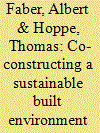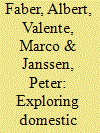| Srl | Item |
| 1 |
ID:
117275


|
|
|
|
|
| Publication |
2013.
|
| Summary/Abstract |
There is considerable scope for energy efficiency improvements to the housing stock in the Netherlands. Although, economically, there are many technological opportunities available, the Dutch built environment has difficulty to harvest this potential. This paper applies a sectoral innovation system approach to investigate this apparent paradox. This approach allows to identify and assess systemic barriers that prevent improvement in overall energy efficiency of the Dutch housing sector. Twenty-one experts were interviewed, and a qualitative data analysis was applied to identify barriers, and relate them to key dimensions in the sectoral innovation system framework. From this analysis, we identified poor regulatory design, lack of market demand, and some institutional characteristics of the construction sector as the key systemic barriers that hamper the diffusion of green energy innovations in the Dutch housing sector.
|
|
|
|
|
|
|
|
|
|
|
|
|
|
|
|
| 2 |
ID:
096096


|
|
|
|
|
| Publication |
2010.
|
| Summary/Abstract |
Micro-cogeneration (micro-CHP) is a new technology at the household level, producing electricity in cogeneration with domestic heating, thereby increasing the overall efficiency of domestic energy production. We have developed a prototypical agent-based simulation model for energy technologies competing for demand at the consumer level. The model is specifically geared towards the competition between micro-CHP and incumbent condensing boilers. In the model, both technologies compete on purchase price and costs of usage, to which various (types of) consumers decide on the installation of either technology.
Simulations with various gas and electricity prices show that micro-CHP diffusion could be seriously inhibited if demand for natural gas decreases, e.g. due to insulation measures. Further simulations explore various subsidy schemes. A subsidy for purchase is only found to be effective within a limited range of €1400-3250. A subsidy based on decreasing price difference between the competing technologies is much more cost effective than fixed purchase subsidies. Simulations of a subsidy scheme for usage show that a fast market penetration can be reached, but this does not yet take full advantage of technological progress in terms of decreasing CO2 emissions. Selection of the most effective scheme thus depends on the policy criteria assumed.
|
|
|
|
|
|
|
|
|
|
|
|
|
|
|
|